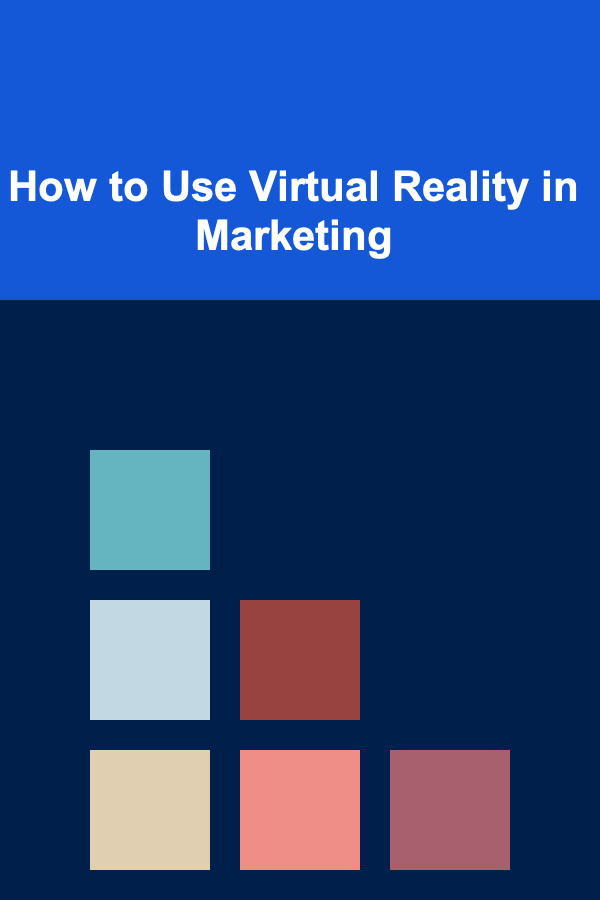
How to Use Virtual Reality in Marketing
ebook include PDF & Audio bundle (Micro Guide)
$12.99$5.99
Limited Time Offer! Order within the next:

Virtual Reality (VR) has become one of the most intriguing and transformative technologies of the 21st century. Initially emerging in the gaming and entertainment sectors, its applications have since expanded far beyond entertainment, particularly into the world of marketing. Today, brands from various industries are experimenting with and successfully integrating VR into their marketing strategies. In this article, we will explore how VR can be used effectively in marketing, the benefits it offers, and the challenges brands may face while incorporating VR into their campaigns.
What is Virtual Reality (VR)?
Virtual Reality (VR) is an immersive technology that allows users to interact with a three-dimensional, computer-generated environment. Unlike traditional media such as images or videos, VR enables users to be fully immersed in a simulated environment, often through the use of a VR headset. The experience is interactive, and users can manipulate the environment or objects within it, creating a sense of presence in the virtual world.
VR differs from Augmented Reality (AR), which overlays digital content onto the real world, by creating a fully immersive environment that completely replaces the real world for the user. With advancements in VR technology, the sensory experiences have become more lifelike, providing a highly immersive experience that has caught the attention of marketers.
The Role of Virtual Reality in Marketing
In marketing, VR offers a unique advantage: the ability to immerse customers in an experience that is both engaging and interactive. It allows brands to go beyond the traditional forms of media and create memorable experiences that deepen consumer engagement. Marketers are increasingly using VR to provide experiences that are designed to attract, inform, and entertain potential customers in a way that traditional advertising methods cannot.
1. Enhancing Customer Engagement
One of the key benefits of VR in marketing is its ability to boost customer engagement. Traditional forms of advertising such as print ads, radio commercials, and TV spots are often passive forms of communication where the consumer is a mere observer. In contrast, VR allows consumers to actively participate in the experience, fostering a deeper connection with the brand. For example, a car manufacturer could offer a VR test drive that allows potential customers to experience the car's features and performance in a virtual environment before making a purchase decision.
By offering an interactive, immersive experience, brands can generate greater emotional involvement from their audience. This emotional connection can lead to higher levels of brand loyalty and consumer satisfaction.
2. Virtual Store Tours and Product Demos
Virtual Reality has the potential to revolutionize the way customers experience products, particularly in industries where physical interaction is crucial. Brands can create virtual store tours, allowing customers to browse their product offerings from the comfort of their homes. This is especially beneficial for industries like retail, real estate, and tourism, where consumers typically need to see the products or properties in person to make purchasing decisions.
For example, a furniture company can create a virtual showroom where customers can explore different products, virtually place them in their homes, and interact with various configurations. A real estate agency can offer virtual property tours, allowing potential buyers to explore houses or apartments remotely, thus saving time and travel costs.
3. Virtual Events and Experiences
Another innovative application of VR in marketing is the creation of virtual events and experiences. VR allows companies to organize events that attendees can participate in from anywhere in the world. Whether it's a product launch, an industry conference, or a concert, VR can provide an immersive experience for attendees who cannot physically be present at the event.
A great example of this is the use of VR in fashion shows. Fashion brands like Tommy Hilfiger and Balenciaga have used VR to broadcast their fashion shows to a global audience, allowing viewers to experience the event from different angles, just as if they were sitting in the front row.
4. VR for Training and Education
Beyond customer-facing applications, VR is also being used by brands to train and educate their employees, partners, and even customers. In the context of marketing, VR can be used to train employees on new products, customer service techniques, or even store layouts. For example, a retail chain might use VR to simulate real-world customer interactions to train sales staff on how to provide better service.
Additionally, VR can be used for educational purposes to promote products. A company that sells complex products, like tech gadgets or industrial equipment, can use VR to create instructional content that helps customers better understand how to use the product. By offering hands-on virtual training sessions, companies can empower their customers to use their products more effectively.
Benefits of Using Virtual Reality in Marketing
The application of VR in marketing is a powerful tool for companies looking to stand out in a crowded marketplace. Some of the key benefits include:
1. Immersive Consumer Experiences
Unlike traditional advertising, which relies on visuals and sound, VR offers an entirely immersive experience that can deeply affect the consumer's emotions and perceptions of a brand. When consumers are fully immersed in a VR experience, they are more likely to remember the brand, its message, and the experience itself. This can lead to higher conversion rates and long-lasting brand recall.
2. Increased Customer Satisfaction
By providing consumers with interactive, engaging experiences, VR allows brands to connect with their customers on a deeper level. This creates a more memorable and satisfying experience for customers, which can increase brand loyalty and encourage repeat business. When customers are able to interact with products or services before making a purchase, they can make more informed decisions, leading to greater satisfaction with their purchases.
3. Competitive Advantage
As VR technology becomes more accessible, it offers companies the opportunity to differentiate themselves from competitors. Brands that adopt VR early in their marketing strategies can stand out as innovators and forward-thinking companies. This can increase their visibility and attract tech-savvy consumers who are looking for cutting-edge experiences.
4. Better Data Collection
VR provides brands with the opportunity to gather valuable data on how customers interact with their products, services, and experiences. With VR, brands can track how users move through virtual environments, how long they spend on specific actions, and even how they react emotionally to certain stimuli. This data can then be used to refine marketing strategies, optimize user experiences, and improve product offerings.
Challenges of Using Virtual Reality in Marketing
While VR holds great potential, it is not without its challenges. Implementing VR in marketing requires significant investment in both technology and content creation, and there are several obstacles that brands must consider before fully integrating VR into their marketing strategies.
1. High Costs of Implementation
Creating high-quality VR content requires specialized knowledge and technology. From building virtual environments to developing interactive elements, the costs associated with VR content creation can be high. Not all brands have the budget to create custom VR experiences, which may limit the widespread use of VR in marketing for smaller companies.
Additionally, VR headsets and other hardware required for consumers to fully experience VR can be expensive, making it a less accessible marketing tool for some brands. However, as technology advances and VR becomes more mainstream, these costs are expected to decrease.
2. Technical Barriers
Despite the growing popularity of VR, there are still technical barriers that need to be addressed. Not all consumers own VR headsets, and not all devices are compatible with VR applications. This limits the reach of VR marketing campaigns, as only a fraction of consumers can fully engage with VR content.
Moreover, there is still a need for higher-quality, more realistic VR experiences. While VR technology has improved significantly, many consumers still experience issues such as lag, low-resolution visuals, and motion sickness. These technical limitations can negatively impact the effectiveness of VR marketing campaigns.
3. Consumer Readiness
Another challenge that brands face when implementing VR in marketing is consumer readiness. While VR is an exciting technology, not all consumers are familiar with it or comfortable using it. This may require marketers to invest in educating their audiences about the benefits of VR and how to use the technology effectively.
Furthermore, some consumers may find VR experiences disorienting or uncomfortable, which could hinder the overall effectiveness of a marketing campaign. It's important for brands to design user-friendly, accessible VR experiences that take consumer comfort into consideration.
How to Implement Virtual Reality in Marketing Campaigns
To successfully incorporate VR into marketing campaigns, brands should consider the following best practices:
1. Start Small and Experiment
For brands that are new to VR, it's best to start small and experiment with different VR applications before launching a large-scale campaign. Consider using VR for specific events or targeted promotions to test the waters and gauge customer interest. This allows brands to refine their approach before committing to more complex VR initiatives.
2. Focus on User Experience
The success of a VR marketing campaign depends heavily on the user experience. Brands should prioritize creating seamless, intuitive experiences that allow users to interact with products or services effortlessly. The content should be engaging, entertaining, and provide real value to the consumer.
3. Ensure Compatibility and Accessibility
To maximize the reach of VR marketing campaigns, brands should ensure that their VR content is compatible with a wide range of devices. While high-end VR headsets like Oculus Rift or HTC Vive offer the best experience, there are also more accessible VR options, such as Google Cardboard, which are compatible with smartphones. This increases the likelihood that a broader audience will engage with the content.
4. Measure and Optimize
As with any marketing strategy, it's important to track and measure the success of VR campaigns. Use analytics tools to gather data on how users are interacting with the content and use this information to optimize future campaigns. Understanding which elements of the VR experience are most engaging can help brands refine their approach and increase the effectiveness of their marketing efforts.
Conclusion
Virtual Reality is a powerful tool that can revolutionize the way brands engage with consumers. By offering immersive, interactive experiences, VR allows brands to stand out in a crowded marketplace and create lasting emotional connections with their audiences. Although the technology comes with challenges such as high costs and technical barriers, the benefits it offers in terms of customer engagement, satisfaction, and competitive advantage make it a worthwhile investment for marketers.
As VR technology continues to evolve and become more accessible, its role in marketing is expected to grow. Brands that embrace VR today are positioning themselves to be at the forefront of a new era of marketing, where innovation and creativity will play a crucial role in driving consumer engagement and brand loyalty.

How to Create Profitable AI Solutions for Passive Income
Read More
How to Maximize Vertical Space for Office Supply Storage
Read More
How To Discuss a Film's Use of Dream Sequences
Read More
Developing Space-Based Solar Power: A Deep Dive
Read More
Dating as an Extrovert: A Comprehensive Guide
Read More
How to Ace Your PA School Interview
Read MoreOther Products

How to Create Profitable AI Solutions for Passive Income
Read More
How to Maximize Vertical Space for Office Supply Storage
Read More
How To Discuss a Film's Use of Dream Sequences
Read More
Developing Space-Based Solar Power: A Deep Dive
Read More
Dating as an Extrovert: A Comprehensive Guide
Read More